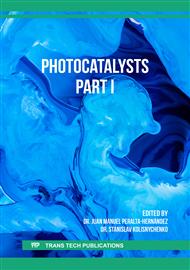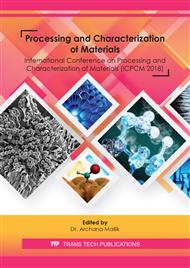[1]
R. Abe, Recent progress on photocatalytic and photoelectrochemical water splitting under visible light irradiation, J. Photochem. Photobiol. C 11 (2010) 179-209.
DOI: 10.1016/j.jphotochemrev.2011.02.003
Google Scholar
[2]
Z. Li, W. Luo, M. Zhang, J. Feng, and Z. Zou, Photoelectrochemical cells for solar hydrogen production: current state of promising photoelectrodes, methods to improve their properties, and outlook, Energy Environ. Sci., 6 (2013) 347-370.
DOI: 10.1039/c2ee22618a
Google Scholar
[3]
M. Samadi, M. Zirak, A. Naseri, E. Khorashadizade, and A. Z. Moshfegh, Recent progress on doped ZnO nanostructures for visible-light photocatalysis, Thin Solid Films 605 (2016) 2-19.
DOI: 10.1016/j.tsf.2015.12.064
Google Scholar
[4]
J. Liu, Y. Liu, N. Liu, Y. Han, X. Zhang, H. Huang, Y. Lifshitz, S.-T. Lee, J. Zhong, Z. Kang, Water splitting. Metal-free efficient photocatalyst for stable visible water splitting via a two- electron pathway, Science 347 (2015) 970-974.
DOI: 10.1126/science.aaa3145
Google Scholar
[5]
Z. Zhao, Y. Sun, F. Dong, Graphitic carbon nitride based nanocomposites: a review, Nanoscale 7 (2015) 15-37.
DOI: 10.1039/c4nr03008g
Google Scholar
[6]
Q. Cai, J. Shen, Y. Feng, Q. Shen, H. Yang, Template-free preparation and characterization of nanoporous g-C3N4 with enhanced visible photocatalytic activity, J. Alloys Compd. 628 (2015) 372-378.
DOI: 10.1016/j.jallcom.2014.12.013
Google Scholar
[7]
K. Ding, L. Wen, M. Huang, Y. Zhang, Y. Lu, and Z. Chen, How does the B,F-monodoping and B/F-codoping affect the photocatalytic water-splitting performance of g-C3N4? Phys. Chem. Chem. Phys. 18 (2016) 19217-19226.
DOI: 10.1039/c6cp02169g
Google Scholar
[8]
S. Zhang, J. Li, M. Zeng, G. Zhao, J. Xu, W. Hu, X. Wang, In Situ Synthesis of Water-Soluble Magnetic Graphitic Carbon Nitride Photocatalyst and Its Synergistic Catalytic Performance, ACS Appl. Mater. Interfaces 5 (2013) 12735-12743.
DOI: 10.1021/am404123z
Google Scholar
[9]
Kresse, G.; Furthmuller, Efficiency of ab-initio total energy calculations for metals and semiconductors using a plane-wave basis set, J. Comput. Mater. Sci. 6 (1996) 15-50.
DOI: 10.1016/0927-0256(96)00008-0
Google Scholar
[10]
Kresse, G.; Furthmuller, Efficient iterative schemes for ab initio total-energy calculations using a plane-wave basis set, J. Phys. Rev. B: Condens. Matter Mater. Phys. 54, 35 (1996) 11169-11186.
DOI: 10.1103/physrevb.54.11169
Google Scholar
[11]
Lee, C. T.; Yang, W. T.; Parr, R. G. Development of the Colic-Salvetti correlation-Energy formula into a functional of the electron density, Phys. ReV. B 37 (1988) 785-789.
DOI: 10.1103/physrevb.37.785
Google Scholar
[12]
P. E. Blöchl, Projector augmented-wave method, Physical Review B 50 (1994) 17953-17979.
DOI: 10.1103/physrevb.50.17953
Google Scholar
[13]
Perdew, J. P.; Burke, K.; Ernzerhof, Generalized Gradient Approximation Made Simple, M.Phys.Rev.Lett.77(1996)3865-3868.
DOI: 10.1103/physrevlett.77.3865
Google Scholar
[14]
Perdew, J. P.; Ernzerhof, M.; Burke, K., Rationale for mixing exact exchange with density functional approximations, J. Chem. Phys. 105 (1996) 9982-9985.
DOI: 10.1063/1.472933
Google Scholar
[15]
A. Tkatchenko, M. Scheffler, Accurate molecular van der Waals interactions from ground-state electron density and free-atom reference data, Phys. Rev. Lett. 102 (2009) 073005.
DOI: 10.1103/physrevlett.102.073005
Google Scholar
[16]
J. Cui, S. Liang, X. Wang, J. Zhang, First principle modeling of oxygen-doped monolayer graphitic carbon nitride, Mater. Chem. Phys. 161 (2015) 194-200.
DOI: 10.1016/j.matchemphys.2015.05.036
Google Scholar
[17]
B. Zhu, J. Zhang, C. Jiang, B. Cheng, J. Yu, First principle investigation of halogen-doped monolayer g-C3N4 photocatalyst, Appl. Catal. B: Environ. 207 (2017) 27-34.
DOI: 10.1016/j.apcatb.2017.02.020
Google Scholar
[18]
M.J. Bojdys, J.O. Müller, M. Antonietti, A. Thomas, Ionothermal synthesis of crystalline condensed, graphitic carbon nitride, Chem. Eur. J. 14 (2008) 8177-8182.
DOI: 10.1002/chem.200800190
Google Scholar
[19]
X. Wang, K. Maeda, A. Thomas, K. Takanabe, G. Xin, J.M. Carlsson, K. Domen, M. Antonietti, A metal-free polymeric photocatalyst for hydrogen production from water under visible light, Nat. Mater.8(2009)76–80.
DOI: 10.1038/nmat2317
Google Scholar
[20]
J. Liu, Effect of phosphorus doping on electronic structure and photocatalytic performance of g-C3N4: Insights from hybrid density functional calculation, J. Alloys Compd. 672 (2016) 271- 276.
DOI: 10.1016/j.jallcom.2016.02.094
Google Scholar
[21]
H. Li, L. Zhou, L. Wang, Y. Liu, J. Lei, J. Zhang, In situ growth of TiO2 nanocrystals on g-C3N4 for enhanced photocatalytic performance, Phys. Chem. Chem. Phys. 17 (2015) 17406- 17412.
DOI: 10.1039/c5cp02554k
Google Scholar
[22]
Gao G., Jiao Y., Waclawik E. R., and Du A., Single Atom (Pd/Pt) Supported on Graphitic Carbon Nitride as an Efficient Photocatalyst for Visible-Light Reduction of Carbon Dioxide, J. Am. Chem. Soc. 138 (2016) 6292-6297.
DOI: 10.1021/jacs.6b02692
Google Scholar
[23]
Z. Sun, J.M.T.A. Fischer, Q. Li, J. Hu, Q. Tang, H. Wang, Z. Wu, M. Hankel, D.J. Searles, L. Wang, Enhanced CO2 photocatalytic reduction on alkali-decorated graphitic carbon nitride, Appl. Catal. B: Environ. 216 (2017) 146-155.
DOI: 10.1016/j.apcatb.2017.05.064
Google Scholar
[24]
J. Wang, Z. Guan, J. Huang, Q. Li, J. Yang, Enhanced photocatalytic mechanism for the hybrid g-C3N4/MoS2 nanocomposite, J. Mater. Chem. A 2 (2014) 7960-7966.
Google Scholar
[25]
D. Misra and T. K. Kundu, Oxygen vacancy induced metal-insulator transition in LaNiO3, Eur. Phys. J. B. 89: 4 (2016) 1-8.
DOI: 10.1140/epjb/e2015-60714-0
Google Scholar
[26]
J. Xu, G. Wang, J. Fan, B. Liu, S. Cao, J. Yu, g-C3N4 modified TiO2 nanosheets with enhanced photoelectric conversion efficiency in dye-sensitized solar cells, J. Power Sources,274 (2015) 77-84.
DOI: 10.1016/j.jpowsour.2014.10.033
Google Scholar
[27]
Q. Hao, S. Hao, X. Niu, X. Li, D. Chen, H. Ding, Enhanced photochemical oxidation ability of carbon nitride by π-π stacking interactions with graphene, Chin. J. Catal. 38 (2017) 278-286.
DOI: 10.1016/s1872-2067(16)62561-5
Google Scholar
[28]
Becke, A.D.; Edgecombe, K.E. A simple measure of electron localization in atomic and molecular systems. J. Chem. Phys. 92 (1990) 5397-5403.
DOI: 10.1063/1.458517
Google Scholar
[29]
Burdett, J.K.; McCormick, T.A. Electron localization in molecules and solids: The meaning of ELF. J. Phys. Chem. A 102 (1998) 6366-6372.
DOI: 10.1021/jp9820774
Google Scholar
[30]
D. Misra and T. K. Kundu, Strain-Controlled Transport Mechanism in Strongly Correlated LaNiO3, J. Electronic Materials, Vol. 46, No. 1, (2017) 150-157.
DOI: 10.1007/s11664-016-4889-3
Google Scholar



